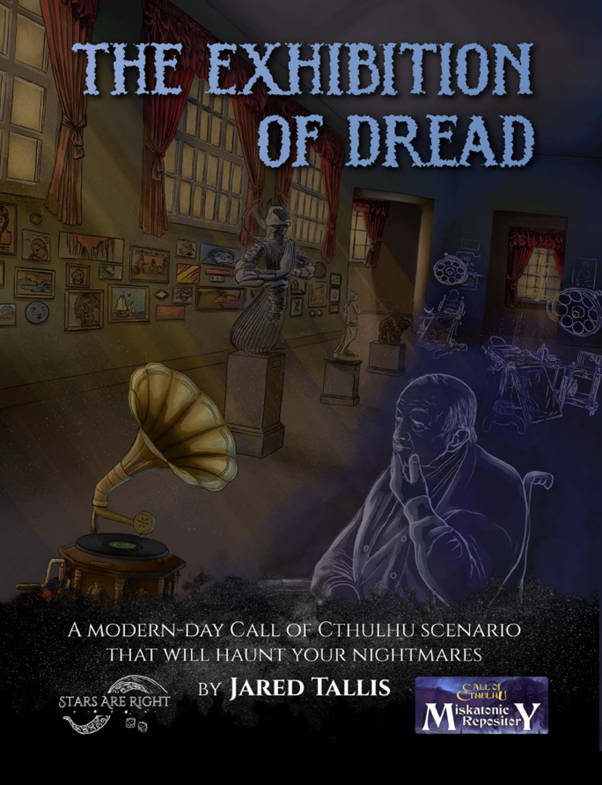The Exhibition of Dread is a modern-day one-short scenario for 2-5 players, set at the Boston College of Modern Art. Clocking in at 42 pages, it contains 5 pre-generated characters, a map and 2 handouts. Written by Jared Tallis, the editing, typesetting and art were done by Stars are Right.

A group of students at the Boston College of Modern Art are brought together in the direst and most traumatising of circumstances: a group project. Real-world horrors aside, the group decide to access the college at night in order to explore its haunted past in order to gain inspiration for their collective art project.
The college itself has a checkered reputation. Considered the best art college around, some graduates are known to have scaled the heights of artistic endeavour, while many others have fallen into addiction and ruin. Prior to becoming a college, the campus building was a sanatorium, and perhaps this has something to do with the persistent rumour that ghosts roam the college halls after dark.

The first problem that the players experience is the college’s 10pm curfew, preventing access to the college at night. Luckily, members of the college Paranormal Society are willing to assist. The opening scene introducing them is reminiscent of a teen slasher movie (it involves a prank using a bottle of ketchup. Enough said), and is effective at setting the tone for the scenario.
Following this, the players must access the campus after curfew and, while success is guaranteed, the players don’t know that. The second, infiltration, scene that follows ought to provide some tension, excitement, and possibly hijinks.

Once in the main building, the third scene begins. While the players are free to explore the two-level building, any attempts to leave are futile. That’s right, it’s a haunted house scene, where bad things happen and there’s no way out. As it happens, the bad things are not all that bad. There’s a series of increasingly sanity-blasting paranormal encounters, which can happily be distributed amongst the players. These include the ghosts of a damaged child and an unhinged hospital orderly. These encounters, along with insights gleaned through investigation in the library and art gallery, reveal the true nature of the college: a place haunted by the pain of those condemned to the sanatorium.

Once the players have received a sufficient dose of terror, a way is opened to the catacombs, and the scenario enters a new mode. The players enter a previously locked door into a downward-sloping corridor and approach the final encounter. Soon they come across a room featuring a poltergeist jump-scare, before finding a bit of foreshadowing in the form of an empty cavern that isn’t natural, but isn’t man-made either. Moving forward, the players go through another corridor and get to the heart of the mystery, and an ultimatum.
This last scene is quite interesting. The players come across a group of hungry ghouls; a cause for concern, without doubt, but one with a twist: The particular ghouls dwelling beneath the college have, over the years, acquired an appreciation of human art. In fact, they have, for reasons unexplained and undoubtedly too eldritch for human understanding, found a way to feed from it. For this reason, they politely explain that they are hungry and would like the players to produce a masterpiece for them on which to feed. If this fails, their bodies will suffice.

The masterpiece creation is the best option (the PCs are artists after all), but the in-game mechanic provided has potential for negative consequences. Of course, the players can also take the ghouls on in a fight, or make a run for it. If they choose to fight, it may be because they have picked up some weapons along the way (ample hand-held weapons are supplied). Running from an encounter in Call of Cthulhu is always a good option, and players can either go further into the catacombs, or back the way they came. In any case, if they leg it sufficiently quickly, the way is open and they’ll make it out.

The exhibition of Dread is a well-constructed scenario that takes players on a journey through a range of horror genres: from teen slasher silliness to infiltration, a claustrophobic haunted house scene, investigation, and a final confrontation offering a range of possible solutions. Couple this with the implicit critique of the past mistreatment of the mentally ill, and we are left with a scenario that not only gives players something to do, but also something to think about. And that, dear reader, is what the best horror scenarios are capable of.

Get it at Drivethrurpg.com
Check out the actual play on the Stars are Right podcast
Disclaimer: Jared Tallis is a friend and co-contributor to this blog, so I think it’s safe to assume that this review carries a high level of bias. In fact, I am explicitly telling you that it does.

Leave a Reply
You must be logged in to post a comment.